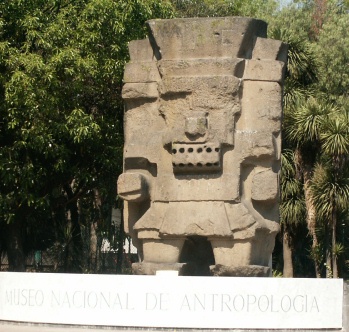 The god of Rain and Water, "Tlaloc" (some think not) at the entrance to the "Museo Nacional de Antropologia" in Chapultepec Park in Mexico City. If this isn't the real Tlaloc, it may be a close family member - the day they trucked this 20 ft tall statue into the city, it rained like crazy!
The god of Rain and Water, "Tlaloc" (some think not) at the entrance to the "Museo Nacional de Antropologia" in Chapultepec Park in Mexico City. If this isn't the real Tlaloc, it may be a close family member - the day they trucked this 20 ft tall statue into the city, it rained like crazy!
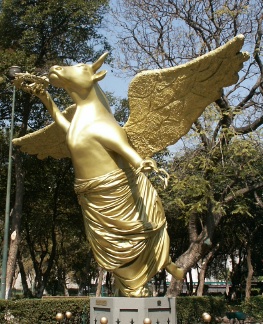 The "Vaca de la Independencia". Inspired by the Angel (well, Winged Victory) on top of the Monument to the Independence.
The "Vaca de la Independencia". Inspired by the Angel (well, Winged Victory) on top of the Monument to the Independence.Arguably the best cow-daptation along the street (see others below). The lifted left-rear hoof completes the illusion.
By the way, we don't have a telephoto lens - but I don't think we fooled too many folks with that closeup on the 'Day1' page.
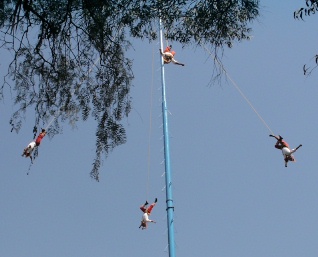 The traditional "Voladores de Papantla", of the Totonaco people along the Gulf of Mexico. They perform in front of the Museo several times daily. Colorful costumes. That pole is about 120 ft tall, and they work without a safety net.
The traditional "Voladores de Papantla", of the Totonaco people along the Gulf of Mexico. They perform in front of the Museo several times daily. Colorful costumes. That pole is about 120 ft tall, and they work without a safety net.
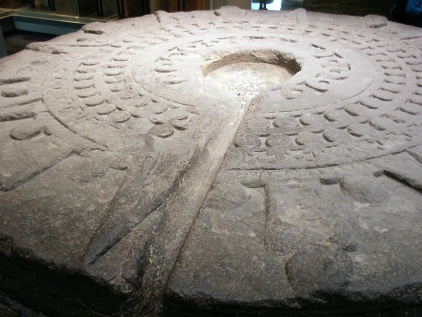 One of several sacrifice stones. Bowl and trough for blood run-off. Ugh! Doggone blood-thirsty deities. Not a welcome sight for captured prisoners of war.
One of several sacrifice stones. Bowl and trough for blood run-off. Ugh! Doggone blood-thirsty deities. Not a welcome sight for captured prisoners of war.
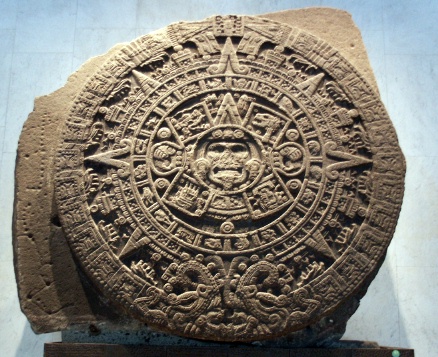 Stone of the Sun
Stone of the SunFrom the museum's description:
The one sculpture which identifies the Mexicas above all others is the Stone of the Sun, discovered in December, 1790, in the Plaza Mayor of the capital of New Spain. Because of its symbolic content, with the names of the days and the cosmogonic suns, it was incorrectly identified as the Aztec Calendar.
This is a large gladiatorial sacrificial altar, known as a temalacatl, which was not finished because of a deep crack that runs from one side to the center of the piece at the rear. Despite the fracture, it must have been used to stage the fights between warriors in the tlacaxipehualiztli ceremony.
In the design of the disk, the face of Xiuhtecuhtil - emerging from the earth hole, holding a pair of human hearts and showing his tongue transformed in a sacrificial knife - can be recognized; he is surrounded by the four suns that preceded the Fifth Sun, in turn inscribed in the sequence of the 20 day signs, framed with the figure of the Sun with its four beams symmetrically accompanied by sacrificial sharp points. The star is surrounded by two Xiuhcoatl or "Fire Serpents", which carry it across the heavens.
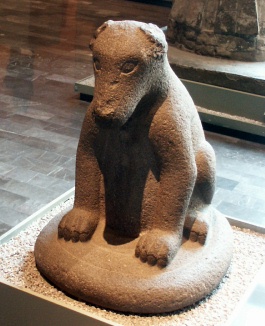 The "Ahuizotl" Mongrel Water Monster. Cross between a dog and a monkey - with a hand on the end of its tail.
The "Ahuizotl" Mongrel Water Monster. Cross between a dog and a monkey - with a hand on the end of its tail.According to legend, the Ahuizotl lived in the lakes, and would cry like a child in distress to lure people as prey, then pull them under with the hand. Their bodies would resurface in 3 days, minus eyes, teeth, and fingernails.
Bad dog!
 Jaguar
Jaguar
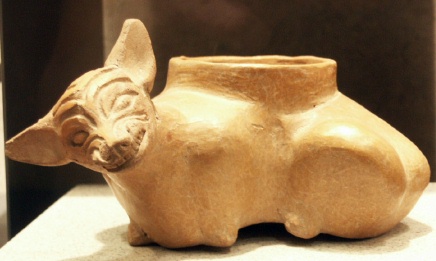 Grrrr!
Grrrr!This pottery rendition of a small dog captures perfectly the snarling, growling nasty look you get if you try to get near its food supply.
 The parasol (umbrella) covering the large patio area in the middle of the Museo. Exhibits are housed in the 2-story buildings that surround the yard.
The parasol (umbrella) covering the large patio area in the middle of the Museo. Exhibits are housed in the 2-story buildings that surround the yard.
 Small carving of the head of a warrior.
Small carving of the head of a warrior.
 That must be Jack. In a pulpit. The folded arms are perfect.
That must be Jack. In a pulpit. The folded arms are perfect.
 "What's UP, dude?" This guy looks like he enjoys standing in a snail's shell.
"What's UP, dude?" This guy looks like he enjoys standing in a snail's shell.
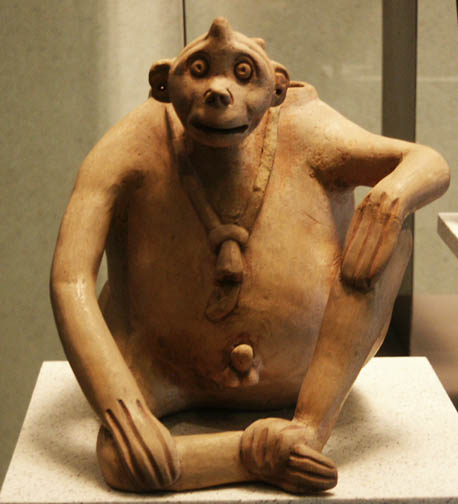 Monkey
Monkey
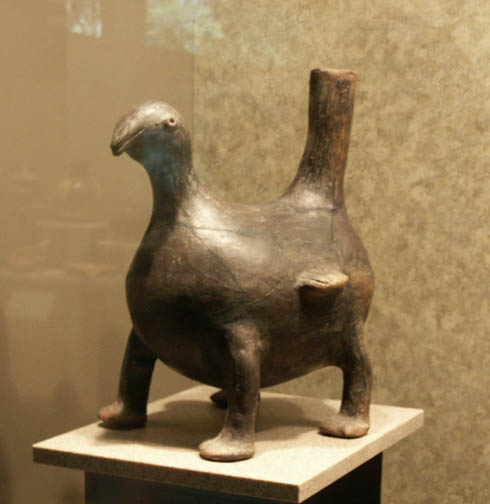 It said on the placard that this was a bird... but I count FOUR legs. Hmm.
It said on the placard that this was a bird... but I count FOUR legs. Hmm.
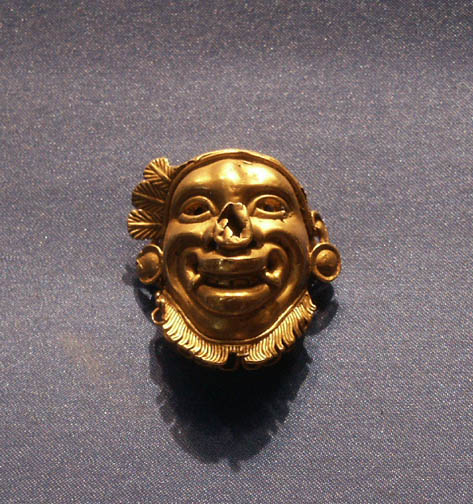 These next 4 pieces are small, and worked in gold. Not many examples of pre-conquest gold pieces exist anymore - most were taken by the conquistadores, melted down, and sent back to Spain.
These next 4 pieces are small, and worked in gold. Not many examples of pre-conquest gold pieces exist anymore - most were taken by the conquistadores, melted down, and sent back to Spain.
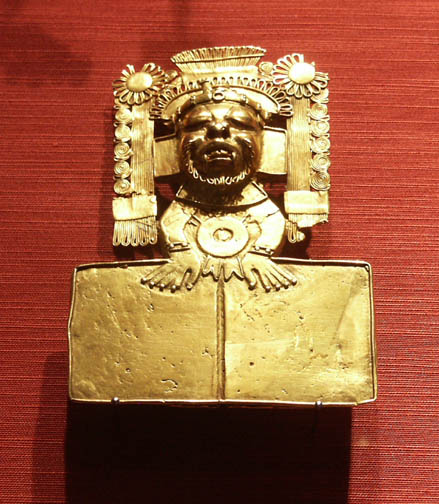
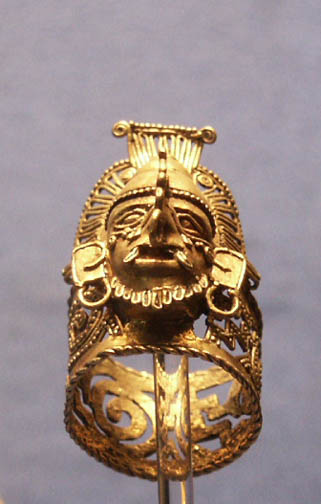 Gold ring... quite a lot of detail, for its size.
Gold ring... quite a lot of detail, for its size.
 This gold pin has turquoise inlay. The source of most turquoise used by the Aztecs was probably northern Arizona.
This gold pin has turquoise inlay. The source of most turquoise used by the Aztecs was probably northern Arizona.
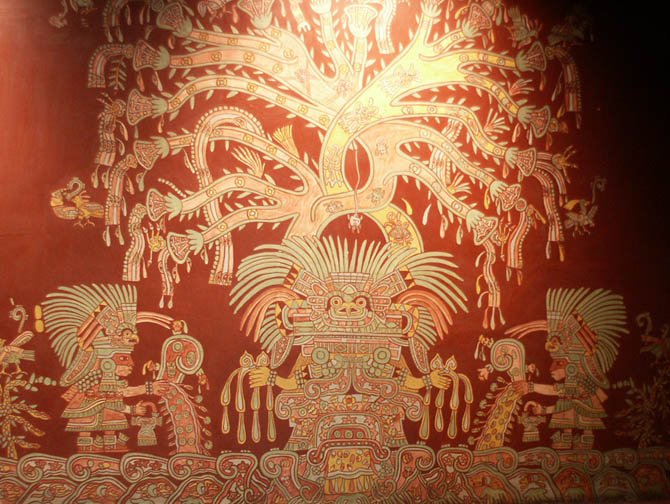 This is the "full rendition" of a mural that we'd seen out at Teotihuacan, the day before.
This is the "full rendition" of a mural that we'd seen out at Teotihuacan, the day before.
 A room-sized replica of the Temple of Quetzacoatl, Teotihuacan.
A room-sized replica of the Temple of Quetzacoatl, Teotihuacan.
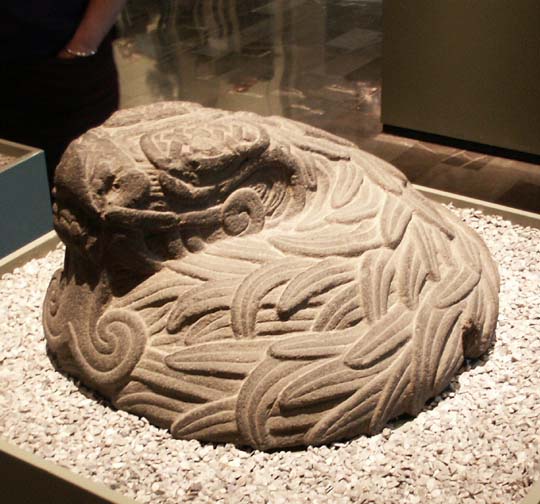 Quetzacoatl himself... well, another interpretation of a feathered serpent.
Quetzacoatl himself... well, another interpretation of a feathered serpent.
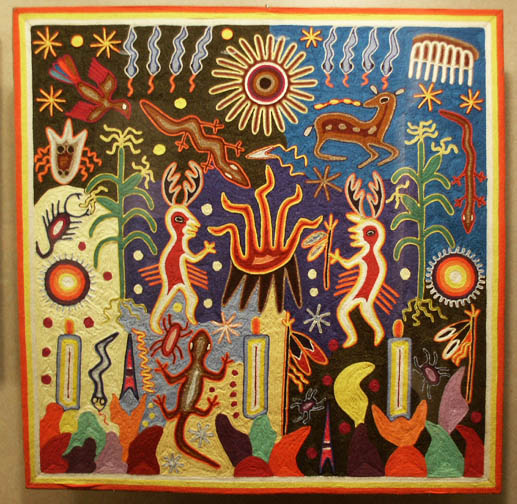 String art, wonderful composition, color, and workmanship! Contemporary work by descendants of pre-conquest peoples.
String art, wonderful composition, color, and workmanship! Contemporary work by descendants of pre-conquest peoples.
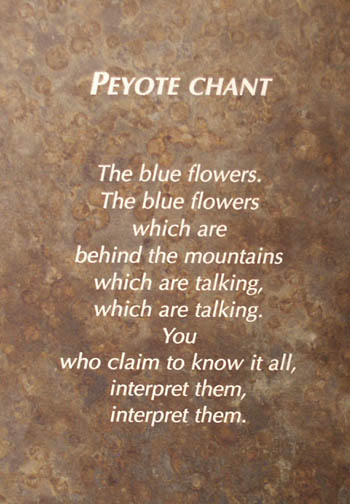 Peyote chant.
Peyote chant.If you couldn't read this in spanish, the translation may help a little. I don't know the melody for these lyrics - and it's probably not available for download off the internet, either.
What I want to know is, when you wake up the morning after the party, is this catchy tune stuck in your head? It's possible you won't remember what the talking blue flowers said, after all.
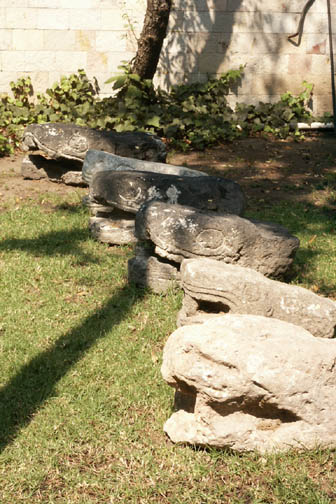 There seem to be so many of these serpent heads (and other artifacts) that some of them are kept outside. Makes for an interesting garden.
There seem to be so many of these serpent heads (and other artifacts) that some of them are kept outside. Makes for an interesting garden.
 This vase is an armadillo, standing on its hind legs and tail, with its forelegs lifted up. Looks to be smiling. Wonderful.
This vase is an armadillo, standing on its hind legs and tail, with its forelegs lifted up. Looks to be smiling. Wonderful.
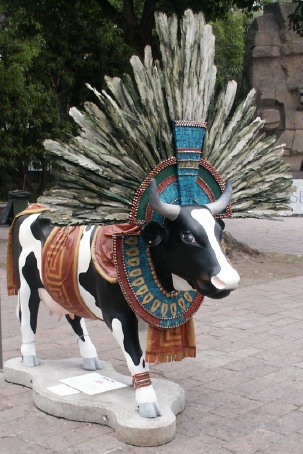 Done with the Museo...
Done with the Museo...Next, we walked along Reforma and enjoyed dozens of "prepared" Cows, sponsored by companies and individuals. All were at least painted, but others had extra parts or foreign objects, in or around. Some of them were just wonderful!
This must be Montezuma's ride (everyone knows there weren't any horses in Mexico until the Spaniards arrived. Hey wait - when did COWS arrive?).
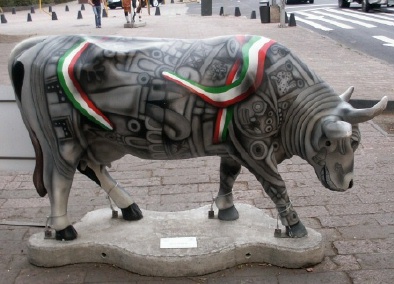 Aztec Sun Stone paintjob, with mexican flag-colored sash.
Aztec Sun Stone paintjob, with mexican flag-colored sash.
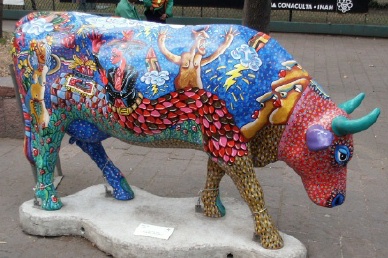 Modern art, with a 'Garden of Eden' motif.
Modern art, with a 'Garden of Eden' motif.
 The original inspiration for the popular Pontiac "Firecow". The horn wasn't all that sharp.
The original inspiration for the popular Pontiac "Firecow". The horn wasn't all that sharp.
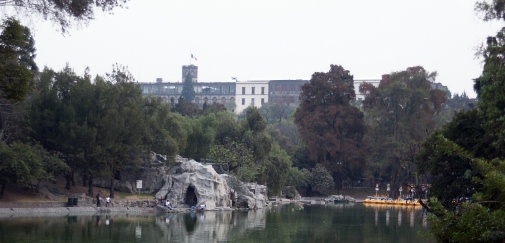 Okay, getting serious again (but, why bother?).
Okay, getting serious again (but, why bother?).The Chapultepec Castle, home of Maximillian and Carlota, above one of the park's lakes. Paddle boats and row boats for rent.